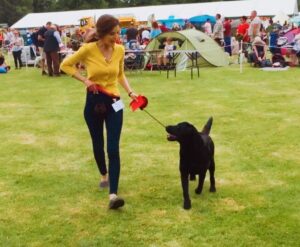Barks Blog
Creating Calm? Why Context Is Key!

by Anna Francesca Bradley
When I first started my journey in training and behavioral therapy (with dogs), I must admit that initially my focus was quite narrow. I looked at what was right in front of me—the dog’s dislike of being touched, the fear of being left, the response to unfamiliar dogs in the park—and addressed it according to that behavior right there and then. Of course, I looked at antecedents of the behavior, possible inadvertent reinforcements, adverse events, and so on. However, although the notion fleetingly crossed my mind, I didn’t spend a proportionate amount of time thinking about contextand the associations formed with and emotional responses to it. Twenty-plus years later, and having gained much more experience, of course, this forms a great part of my thinking, as it should.
When faced with a behavioral issue of any kind, it is easy to focus on the dog’s tangible associations. For example, an owner complains that their dog is unhappy when groomed. The dog may display severe aggressive behaviors, and this may result in the dog becoming very difficult to handle. Perhaps a dog displays destructive behavior or exhibits signs that they are deeply anxious when left alone. The same dog may be especially unhappy when travelling in a car or left in a crate.
In the first instance, with the dog who dislikes being groomed, we may subsequently work on desensitization strategies with particular grooming tools, and this may partially improve behavioral signs, but it may not fully improve the dog’s emotional response when there is something else blocking behavioral resolution. Whereabouts is the dog groomed? Does the dog display a willingness to enter the grooming area? Does the dog anticipate that something negative is about to happen when entering the grooming area?
As an example, recently my own dog required frequent footbaths to cure a nasty condition in his front paws. To ease the washing process, I carried out the footbaths in my utility room, which also has an exterior door to the house. My dog did not enjoy the routine at all, and after several footbaths, he would not enter the utility room, even if I wanted him to use the area for a quick “in/out” of the house to go for walks. I had conditioned a negative emotional response toward that particular context, and even now he is reluctant to visit that particular room. (I am working on it!)
So, in the instance with the dog who is unhappy when groomed, it is not only the action of grooming—the inadvertent pulling of fur, maybe the odd nick—but the association of that action with the context of those negative events that becomes the issue. Similarly, in the example of the dog who is anxious or destructive when left alone or in a confined space, feelings of claustrophobia can exacerbate behavioral responses. Dogs also can quickly learn that ‘When I enter the kitchen, that’s where I’ll soon be left’ (cue feelings of panic) or ‘I enter the car, soon I’ll have feelings of nausea’ (cue feelings of anxiety). Context can be a big issue for many dogs—not simply the tangible aspect of disliking a particular brush, being left in a specific room, entering a car, or hating a crate.
Desensitization, response substitution, overshadowing, counter conditioning techniques, and so on, are all extremely powerful on their own and when used in combination, but broader thinking that includes how the dog thinks about the setting he is in is required.
Conditioning Calm
If we are to step back and cover all bases including context, what is the best way to go about this? One of my favorite methods is place training. There are several synonyms here—place training, mat training, location training—but essentially, they all refer to the same technique of conditioning calm. The greatest aspect of this technique is creating a mobile, calm space. The beauty of place training is conditioning an emotional calm context in a location where previously this did not exist. You can then work on desensitization to touch and grooming tools, for instance, and then put the two together. Well taught, this works brilliantly—you get a dog who feels better about the brushing tools and the process and environment.
Place Training Tips
- I like to clicker train the process. It allows you to mark the dog’s correct response on the mat much more accurately.
- For a place training item, I suggest starting with something like a heavy carpet square that the dog will not ruck. The item needs to be something firm so that the dog will not be distracted by scratching, rolling up, or digging the “to be conditioned” area. A low platform may also be used as a place training area. Make sure the item is around the size of the dog when the dog is lying down.
- Always remove the mat or other place training item when you are not training.
- Start place training at a time when the dog is already relaxed and not when they are excited.
- Use a cue (e.g., ‘on your mat’) and ask for a ‘down’ (click-treat). This is all you should ask for initially. It is crucial that the dog is fully relaxed and not hovering or poised to jump off the mat. The idea is that the dog is fully settled—remember, you are conditioning a calm and fully relaxed state, not just a lie down.
- Gradually build time: ‘on your mat’ (down) + 3 secs, and increase progressively. Be sure to not rush this process, or the dog will become frustrated.
Once successfully introduced, the dog should see the mat as a rewarding space—‘Yay, there’s my mat. I’ll head for that and lie down and relax and I’ll be rewarded for it!’ It really is great to watch when you’ve cracked this, and you can give yourself a huge pat on the back for conditioning a calm context.
Applications of Place Training
The real standout of place training is that the “place” is a mobile space associated with feelings of being relaxed and calm—you can take it anywhere you like. I use place training extensively in dog reactivity cases. Many of these dogs suffer with very high arousal, and the context of the park or even being outside of the house becomes associated with feelings of anxiety, tension, frustration, excitement—many varied emotions that manifest in inappropriate behaviors.
After an initial assessment, I typically ask owners to work on place training on their own for 4 weeks or so. For many of these dogs, arousal begins to really hit high levels when they travel in the car to work with me, so we work on place training to facilitate feelings of calmness on round trips in the car, first with no end and then approaching the dog park. I’ll incorporate a lot of work on low platforms with desensitization and response substitution techniques, as well as long, settled ‘downs’ at a distance from other dogs. I have found that the addition of place training has helped many of these dogs who otherwise would simply “fire off” immediately upon entering the park, even with no trigger in sight.
Similarly, perhaps one of the most frequently used applications of place training is to help dogs behave more appropriately with visitors—thinking about those excitable puppies or boisterous teens! Of course, they’re not really doing anything bad—they just want to meet and greet and say hello—but not everyone wants paws all over them! Place training (perhaps initially with the dog on lead, especially if the dog is very young) provides a means to have a demarcated area for the dog to be and be rewarded for staying in that one location rather than hurling themselves around the house at unsuspecting guests. Of course, the behavior of guests, too, is important—that they offer no encouragement toward the dog.
I have also used the technique very successfully for the management of anxiety. Here, place training serves as a rewarding safe space in a previously anxiety-provoking context. For example, I worked with a dog who was fearful when young children in the family came to visit, even though they fully respected the dog. In this instance, the context was particularly challenging. We worked extensively on a variety of desensitization techniques, but also used place training. This worked really well to alter the dog’s emotional response.
Place training is certainly not the “be all” and most definitely needs to be utilized in conjunction with other behavioral techniques, but I find it to be a positive asset in behavior modification. Looking and thinking about how dogs view the world around them and how that plays a part in the difficulties they face is paramount to reaching a resolution when it comes to behavioral work-throughs. Place training is certainly one part of that jigsaw puzzle!
About the Author

